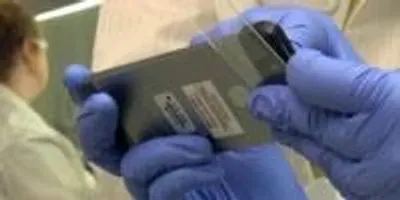 Researchers look at simulated anthrax spores through a 1000x microscope created on a 3D printer that attaches to a cell phone.Pacific Northwest National Laboratory
Researchers look at simulated anthrax spores through a 1000x microscope created on a 3D printer that attaches to a cell phone.Pacific Northwest National Laboratory
RICHLAND, Wash.—At one o'clock in the morning, layers of warm plastic are deposited on the platform of the 3D printer that sits on scientist Rebecca Erikson's desk. A small plastic housing, designed to fit over the end of a cell phone, begins to take shape. Pulling it from the printer, Erikson quickly pops in a tiny glass bead and checks the magnification.
In the space of about 10 minutes, Erikson, who works for the U.S. Department of Energy's Pacific Northwest National Laboratory, has developed exactly what her colleagues asked for—a sleek, simple and inexpensive way to turn a cell phone into a high powered, high quality microscope that can be used to identify biological samples in the field.
Using glass spheres as a microscope lens is not a new idea, optically, but the small size of the housing combined with very high magnification and extremely low cost is what makes this device practical.
"We believe it can fill a need for professional first responders, and also for teachers and students in the classroom, health workers and anyone who just wants an inexpensive microscope readily available," said Erikson an applied physicist.
There are a few other devices that use a variety of approaches to leverage a cell phone camera into a microscope, but many are bulky, expensive, hard to align, or are lower powered. The PNNL team developed an inexpensive version that can magnify a sample by 1000 times. For specific applications, lower magnifications are easily achievable.
PNNL made the design specifications available, free of charge, to the public so anyone with access to a 3D printer can make their own microscope.
The microscope slips over the camera lens of the cell phone and is no thicker than a phone case. It's designed to fit several popular cell phone brands and tablets. The material cost, not including the printer, is under $1.
Can identify "suspicious powder" threats
Low cost was a driver in the development. The microscope needed to be so cheap it could literally be thrown away—if it gets contaminated. As part of PNNL's national security programs, Erikson's colleagues were working on an internally funded research and development project targeting a specific Department of Homeland Security need for rapid bio detection technologies.
"We interviewed a lot of first responders, public health labs and civil support teams," said biochemist Cheryl Baird. "They told us the first thing they do when a suspicious powder sample gets to the lab, is to put it under the microscope. An inexpensive, yet powerful microscope in the field could be used to quickly determine whether the material is a threat or a hoax. Combine the microscope with the picture sharing capability of a smart phone and now practically anyone can evaluate a sample at the source and have a trained microbiologist located in a lab elsewhere interpret the results within minutes."
The sample must first be put into a slide for viewing. If the sample turns out to be a toxic biological material, or the responder is looking at a blood sample, the slip-on microscope can be disposed of and the cell phone fitted with a new microscope for additional work.
Using inexpensive glass beads traditionally used for reflective pavement markings at airports, the PNNL team has demonstrated 1000x magnification, which is necessary to see tiny pathogens. They have also made a 350x version, which is adequate to identify parasites in a blood samples or protozoa in drinking water. A 100x version enables children to investigate common items like salt grains and flower petals in much greater detail.
"We feel there are many uses out there including human and veterinary medicine in developing countries," said Janine Hutchison a microbiologist at PNNL. "We are also excited about engaging kids in science. School districts have a hard time providing enough microscopes for students. Our science education staff is actively engaged in getting it into the hands of local school children this fall."
This project was developed with internal discretionary funds that advance early stage ideas to enhance PNNL's core scientific and technical disciplines.
"We have a strong optics capability at PNNL," said Baird. "Combined with our national security work, we plan to continue to develop tools that will help protect our nation and assist those on the front lines."
RICHLAND, Wash.—At one o'clock in the morning, layers of warm plastic are deposited on the platform of the 3D printer that sits on scientist Rebecca Erikson's desk. A small plastic housing, designed to fit over the end of a cell phone, begins to take shape. Pulling it from the printer, Erikson quickly pops in a tiny glass bead and checks the magnification.
In the space of about 10 minutes, Erikson, who works for the U.S. Department of Energy's Pacific Northwest National Laboratory, has developed exactly what her colleagues asked for—a sleek, simple and inexpensive way to turn a cell phone into a high powered, high quality microscope that can be used to identify biological samples in the field.
Using glass spheres as a microscope lens is not a new idea, optically, but the small size of the housing combined with very high magnification and extremely low cost is what makes this device practical.
To continue reading this article, sign up for FREE to

Membership is FREE and provides you with instant access to eNewsletters, digital publications, article archives, and more.



 Researchers look at simulated anthrax spores through a 1000x microscope created on a 3D printer that attaches to a cell phone.
Researchers look at simulated anthrax spores through a 1000x microscope created on a 3D printer that attaches to a cell phone.







